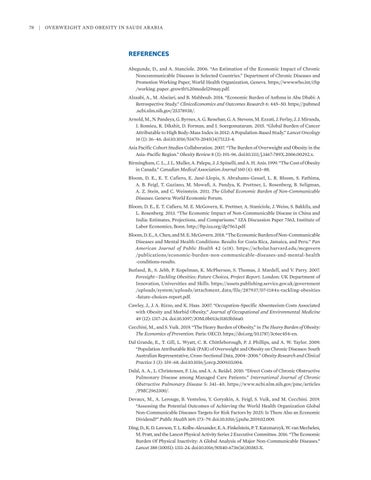78
|
Overweight and Obesity in Saudi Arabia
REFERENCES Abegunde, D., and A. Stanciole. 2006. “An Estimation of the Economic Impact of Chronic Noncommunicable Diseases in Selected Countries.” Department of Chronic Diseases and Promotion Working Paper, World Health Organization, Geneva. https://www.who.int/chp /working_paper_growth%20model29may.pdf. Alzaabi, A., M. Alseiari, and B. Mahboub. 2014. “Economic Burden of Asthma in Abu Dhabi: A Retrospective Study.” ClinicoEconomics and Outcomes Research 6: 445–50. https://pubmed .ncbi.nlm.nih.gov/25378938/. Arnold, M., N. Pandeya, G. Byrnes, A. G. Renehan, G. A. Stevens, M. Ezzati, J. Ferlay, J. J. Miranda, I. Romieu, R. Dikshit, D. Forman, and I. Soergomataram. 2015. “Global Burden of Cancer Attributable to High Body-Mass Index in 2012: A Population-Based Study.” Lancet Oncology 16 (1): 36–46. doi:10.1016/S1470-2045(14)71123-4. Asia Pacific Cohort Studies Collaboration. 2007. “The Burden of Overweight and Obesity in the Asia–Pacific Region.” Obesity Review 8 (3): 191–96. doi:10.1111/j.1467-789X.2006.00292.x. Birmingham, C. L., J. L. Muller, A. Palepu, J. J. Spinelli, and A. H. Anis. 1999. “The Cost of Obesity in Canada.” Canadian Medical Association Journal 160 (4): 483–88. Bloom, D. E., E. T. Cafiero, E. Jané-Llopis, S. Abrahams-Gessel, L. R. Bloom, S. Fathima, A. B. Feigl, T. Gaziano, M. Mowafi, A. Pandya, K. Prettner, L. Rosenberg, B. Seligman, A. Z. Stein, and C. Weinstein. 2011. The Global Economic Burden of Non-Communicable Diseases. Geneva: World Economic Forum. Bloom, D. E., E. T. Cafiero, M. E. McGovern, K. Prettner, A. Staniciole, J. Weiss, S. Bakkila, and L. Rosenberg. 2013. “The Economic Impact of Non-Communicable Disease in China and India: Estimates, Projections, and Comparisons.” IZA Discussion Paper 7563, Institute of Labor Economics, Bonn. http://ftp.iza.org/dp7563.pdf. Bloom, D. E., A. Chen, and M. E. McGovern. 2018. “The Economic Burden of Non-Communicable Diseases and Mental Health Conditions: Results for Costa Rica, Jamaica, and Peru.” Pan American Journal of Public Health 42 (e18). https://scholar.harvard.edu/mcgovern /publications/economic-burden-non-communicable-diseases-and-mental-health -conditions-results. Butland, B., S. Jebb, P. Kopelman, K. McPherson, S. Thomas, J. Mardell, and V. Parry. 2007. Foresight—Tackling Obesities: Future Choices, Project Report. London: UK Department of Innovation, Universities and Skills. https://assets.publishing.service.gov.uk/government /uploads/system/uploads/attachment_data/file/287937/07-1184x-tackling-obesities -future-choices-report.pdf. Cawley, J., J. A. Rizzo, and K. Haas. 2007. “Occupation-Specific Absenteeism Costs Associated with Obesity and Morbid Obesity.” Journal of Occupational and Environmental Medicine 49 (12): 1317–24. doi:10.1097/JOM.0b013e31815b56a0. Cecchini, M., and S. Vuik. 2019. “The Heavy Burden of Obesity,” in The Heavy Burden of Obesity: The Economics of Prevention. Paris: OECD. https://doi.org/10.1787/3c6ec454-en. Dal Grande, E., T. Gill, L. Wyatt, C. R. Chittleborough, P. J. Phillips, and A. W. Taylor. 2009. “Population Attributable Risk (PAR) of Overweight and Obesity on Chronic Diseases: South Australian Representative, Cross-Sectional Data, 2004–2006.” Obesity Research and Clinical Practice 3 (3): 159–68. doi:10.1016/j.orcp.2009.03.004. Dalal, A. A., L. Christensen, F. Liu, and A. A. Reidel. 2010. “Direct Costs of Chronic Obstructive Pulmonary Disease among Managed Care Patients.” International Journal of Chronic Obstructive Pulmonary Disease 5: 341–40. https://www.ncbi.nlm.nih.gov/pmc/articles /PMC2962300/. Devaux, M., A. Lerouge, B. Ventelou, Y. Goryakin, A. Feigl, S. Vuik, and M. Cecchini. 2019. “Assessing the Potential Outcomes of Achieving the World Health Organization Global Non-Communicable Diseases Targets for Risk Factors by 2025: Is There Also an Economic Dividend?” Public Health 169: 173–79. doi:10.1016/j.puhe.2019.02.009. Ding, D., K. D. Lawson, T. L. Kolbe-Alexander, E. A. Finkelstein, P. T. Katzmarzyk, W. van Mechelen, M. Pratt, and the Lancet Physical Activity Series 2 Executive Committee. 2016. “The Economic Burden Of Physical Inactivity: A Global Analysis of Major Non-Communicable Diseases.” Lancet 388 (10051): 1311–24. doi:10.1016/S0140-6736(16)30383-X.






